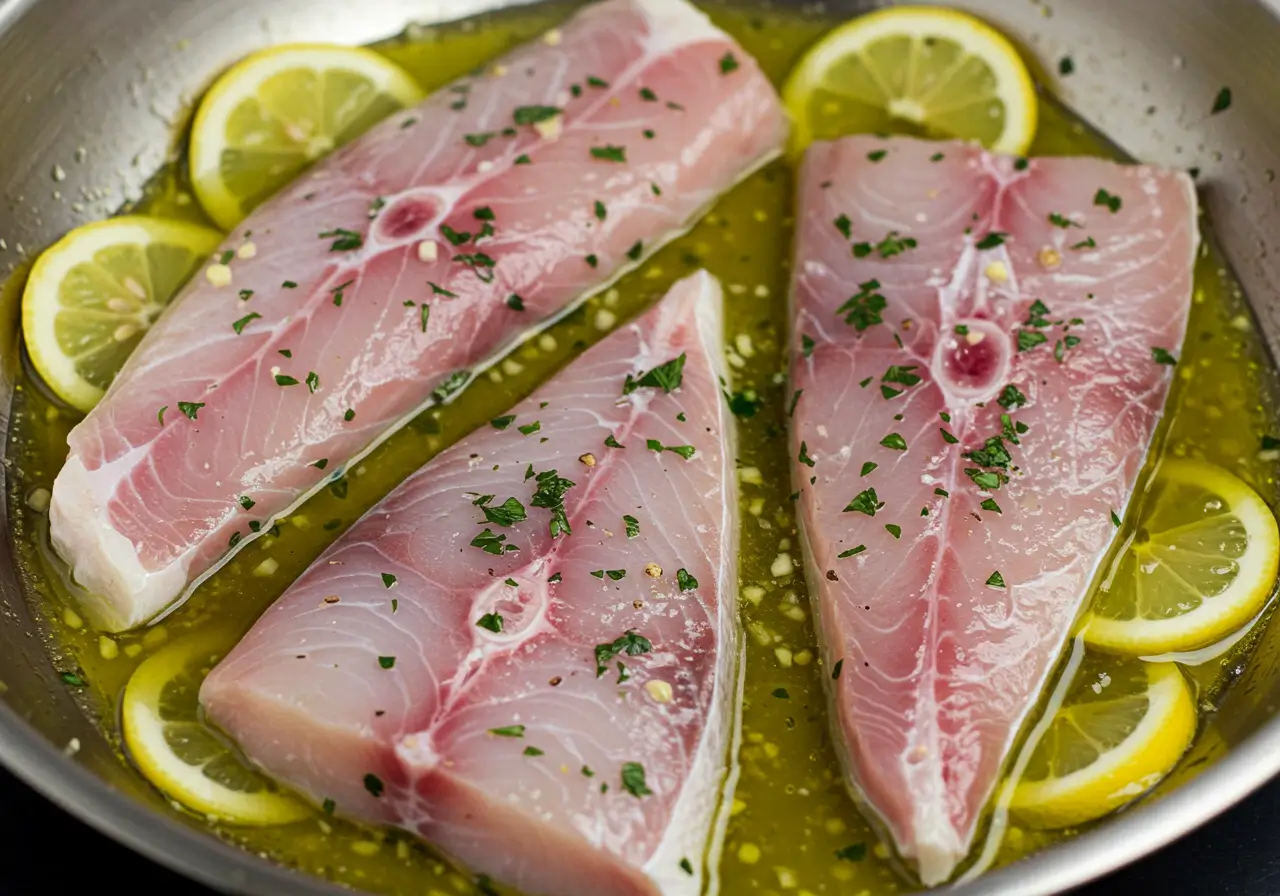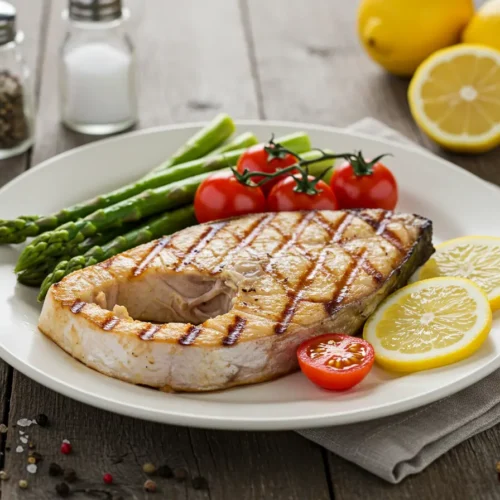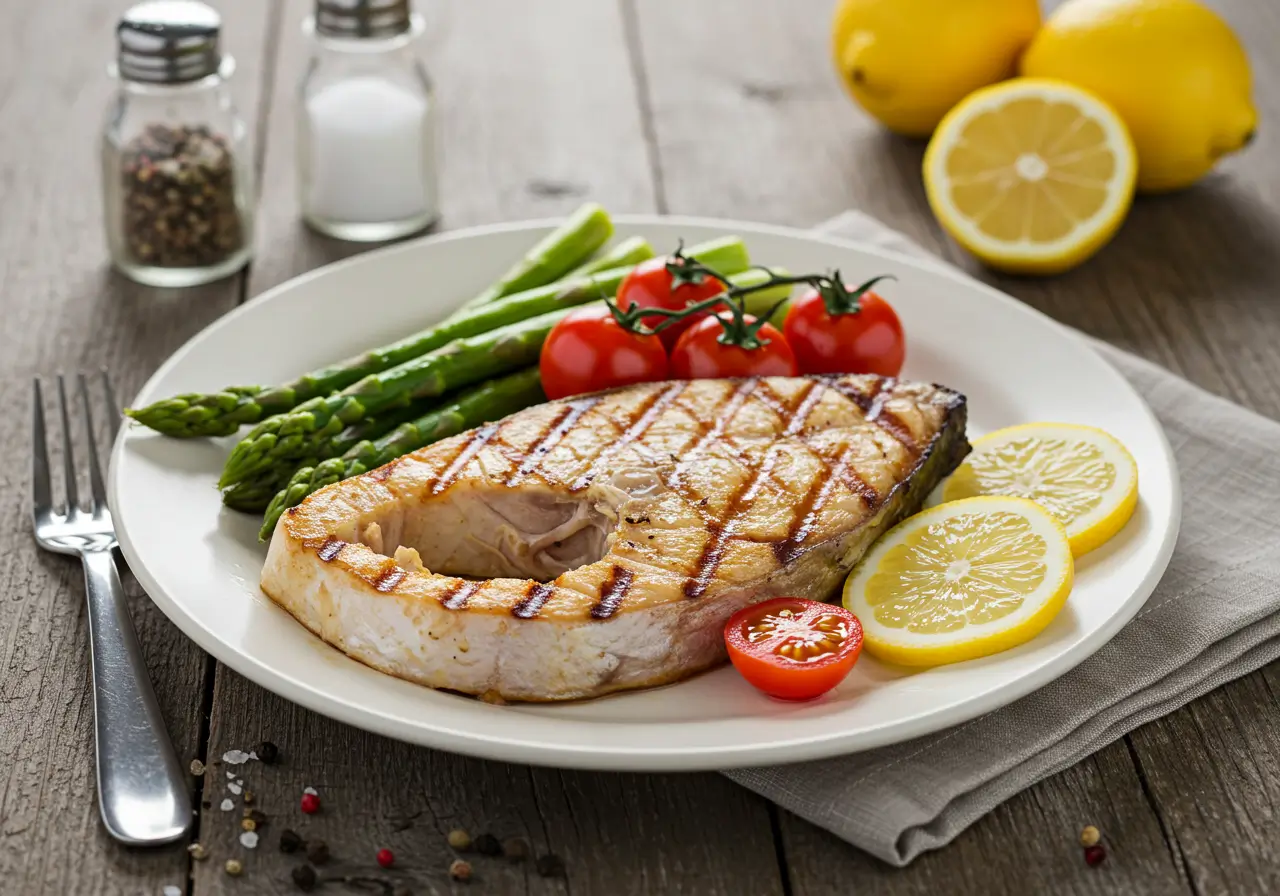Swordfish recipe is a flavorful, meaty fish that’s perfect for grilling, pan-searing, baking, and broiling. With its mild taste and firm texture, it pairs wonderfully with a variety of seasonings and cooking methods, making it a versatile option for any dinner table. Whether you’re a seasoned cook or a beginner, this article will guide you through everything you need to know to prepare a delicious swordfish recipe. From selecting the right cut of fish to exploring different cooking techniques, we’ll cover it all. So, if you’re ready to take your swordfish cooking skills to the next level, read on for a detailed and easy-to-follow recipe.
Introduction to Swordfish Recipe
Why Swordfish Is a Great Choice for Cooking
Swordfish is one of those fish that stands out for its texture and flavor. Unlike delicate fish like salmon or tilapia, swordfish has a firm, meaty texture that holds up well to a variety of cooking methods. It’s an excellent option if you’re looking for something hearty and filling, yet still healthy and light. Plus, its mild flavor makes it a great canvas for a wide range of seasonings and marinades. Whether grilled, pan-seared, or baked, swordfish is always a hit with those looking for something both flavorful and satisfying.
The Unique Flavor and Texture of Swordfish
What really sets swordfish apart from other fish is its steak-like texture. It’s not flaky or delicate; rather, it’s dense and juicy, making it perfect for grilling and pan-searing. When cooked properly, it’s moist and tender inside, with a crispy, golden crust outside.Its mild yet slightly sweet flavor pairs beautifully with everything from tangy marinades to rich sauces. That combination of texture and flavor is why swordfish is so loved by home cooks and chefs alike. Whether you’re trying a simple grilled swordfish recipe or something more adventurous, swordfish is a fantastic choice.
Swordfish Recipe Overview
What Makes This Swordfish Recipe Special?
This swordfish recipe stands out because it emphasizes simplicity and freshness, using just a few ingredients to highlight the fish’s natural flavors. Unlike other complex fish dishes, this recipe focuses on enhancing the swordfish’s mild, sweet taste with carefully selected seasonings and a touch of lemon. Whether you’re grilling, pan-searing, or baking, this recipe ensures that the swordfish comes out tender, juicy, and packed with flavor.
Key Techniques for Cooking Swordfish Perfectly
The key to a perfect swordfish recipe lies in using the right cooking methods. Swordfish Recipe, being a firm fish, responds well to grilling, pan-searing, and baking. Each technique brings out different textures and flavors, but the goal is always the same: achieve a tender and moist interior with a crisp, golden crust. It’s important to cook swordfish over medium heat to prevent overcooking, which can dry it out. A good swordfish recipe will teach you how to monitor cooking times, ensuring that your fish remains juicy while developing that delicious caramelized outer layer.
Ingredients for the Perfect Swordfish Recipe
Fresh Swordfish: What to Look for in Quality Fish
When it comes to a successful swordfish recipe, the quality of the fish is paramount. Look for swordfish steaks that are firm to the touch and have a slight sheen. The flesh should be a pale pink or coral color, and there should be no signs of discoloration or browning. Fresh swordfish will have a clean, ocean-like smell, so avoid any fillets that have a strong fishy odor. You can also ask your fishmonger to provide swordfish that’s recently caught, as this ensures maximum freshness.
Supporting Ingredients: Vegetables, Herbs, and Spices
In addition to the swordfish, the ingredients for a swordfish recipe include a blend of herbs, spices, and vegetables. Fresh herbs like parsley, basil, and thyme work wonderfully as garnishes or in marinades. Vegetables such as asparagus, bell peppers, and tomatoes complement the rich flavor of the fish, adding a satisfying texture and vibrant color to the dish. For the marinade, you’ll typically use olive oil, garlic, and lemon juice, creating a balance of acidity and richness that enhances the natural flavors of the swordfish.
Substitutions and Variations for the Recipe
While this swordfish recipe is designed to highlight the fish itself, feel free to experiment with substitutions. For instance, if you can’t find swordfish, other meaty fish like tuna or mahi-mahi work equally well. You can also customize the marinade to suit your tastes by adding spices like cumin, paprika, or chili flakes for a more intense flavor. Whether you’re preparing this for a summer BBQ or a cozy dinner at home, these small tweaks will elevate your swordfish recipe while keeping it simple.
How to Prepare Swordfish for Cooking

Cleaning and Trimming Swordfish Steaks
Properly preparing your swordfish is essential for getting the best out of your swordfish recipe. If you’ve purchased swordfish steaks, you may need to clean them before cooking. Start by removing any skin (if not already done) and trimming any uneven edges. The flesh should be trimmed into thick steaks or fillets, about 1 to 1.5 inches thick. This thickness helps the fish retain moisture during cooking while allowing for a nice sear on the outside. Make sure to remove any bones as well, as they can detract from the texture of your dish.
Marinating Swordfish for Flavor and Tenderness
Marinating your swordfish recipe can infuse it with additional flavor and help to keep it tender. A basic marinade for swordfish usually involves olive oil, lemon juice, garlic, and a mix of fresh herbs like parsley or thyme. The acid in the lemon juice helps break down the fibers in the fish, making it more tender while also adding a zesty, fresh flavor. You don’t need to marinate swordfish for long—about 15 to 30 minutes will do the trick. However, you can leave it in the marinade for up to an hour if you want a more intense flavor profile. Just be cautious not to over-marinate, as the acid could start cooking the fish if left for too long.
Seasoning Swordfish: Tips for Perfect Flavor Balance
Once marinated, you can add the final touches to the swordfish recipe by seasoning it. A simple sprinkle of salt and pepper is often all it needs. However, if you’re looking for something more adventurous, you can add a pinch of cayenne pepper, paprika, or garlic powder. Just remember to season lightly, as swordfish has a delicate flavor that should shine through, not be overwhelmed by heavy seasoning.
Cooking Methods for Swordfish

Grilling Swordfish: Tips for Success
Grilling is one of the best methods to cook swordfish, as it enhances its natural flavor and gives the fish a delicious smoky char. To achieve the perfect grilled swordfish, start by preheating your grill to medium-high heat. Brush your swordfish steaks with olive oil and season them lightly with salt and pepper. When placing the fish on the grill, make sure the grates are well-oiled to prevent sticking. Grill each side for about 4 to 5 minutes, depending on the thickness of the steak. The goal is to have a crispy, golden-brown exterior while keeping the inside moist and tender. Always use a fish spatula for flipping to avoid breaking the fish. For an extra layer of flavor, consider brushing the swordfish with a tangy marinade or sauce during the last few minutes of grilling.
Pan-Seared Swordfish: A Quick and Delicious Option
If you’re short on time, pan-searing swordfish is another great option. This method allows you to cook the fish quickly while achieving a crispy outer crust. To pan-sear swordfish, heat a skillet over medium-high heat and add a tablespoon of oil or butter. Once the oil is hot, add your swordfish steaks and cook for about 4 to 5 minutes on each side. Pan-searing works best with swordfish that is about 1 to 1.5 inches thick, as it helps develop a golden-brown exterior without overcooking the inside. This method keeps the fish moist and flavorful while giving it a slightly caramelized crust. It’s quick, easy, and perfect for a weeknight dinner.
Baking Swordfish: Perfect for a More Hands-off Meal
Baking is a wonderful, hands-off way to cook swordfish, especially if you want to focus on preparing other dishes or sides. To bake swordfish, preheat your oven to 375°F (190°C). Place the seasoned swordfish steaks on a baking sheet lined with parchment paper or foil. You can also add a bit of butter or olive oil on top of the fish to keep it moist during baking. Bake for about 12 to 15 minutes, depending on the thickness of the fish. Swordfish is done when it’s opaque and flakes easily with a fork. For added flavor, you can sprinkle the fish with fresh herbs or drizzle a citrus sauce before baking.
Broiling Swordfish: Another Flavorful Method to Try
Broiling swordfish is similar to grilling but done in the oven. Set your oven to the broil setting and place the swordfish steaks on a rack about 6 inches from the heating element. Broil the fish for about 5 to 7 minutes, flipping halfway through. Broiling works well for thicker cuts of swordfish and imparts a slightly crisp crust while keeping the inside moist and tender. This method is great if you want a grilled-like result without using an outdoor grill.
Step-by-Step Swordfish Recipe Instructions
Prepping the Swordfish
Before you start cooking your swordfish, it’s important to prepare the fish properly. First, remove the swordfish from the refrigerator and allow it to come to room temperature for about 15 to 20 minutes. This helps it cook more evenly. Next, trim any skin or bones that might still be attached to the steaks. Depending on the size, you might want to cut the swordfish into smaller portions to make serving easier. Once it’s trimmed and prepped, pat the fish dry with a paper towel to remove excess moisture. This ensures a better sear when cooking.
Cooking the Swordfish (Grill, Pan-Seared, or Baked)
Now it’s time to cook your swordfish. You can follow the methods described earlier, depending on your preference and available equipment. If you’re grilling, ensure the grill is preheated and lightly oiled before placing the swordfish on it. Grill each side for 4 to 5 minutes, watching carefully to avoid overcooking. For pan-searing, heat the skillet until hot and add oil. Then, cook the swordfish for 4 to 5 minutes on each side. If you’re baking the swordfish, place it in the oven for 12 to 15 minutes. The key here is not to overcook the fish, as swordfish can become dry if left on the heat for too long.
Adding Finishing Touches: Sauces, Sides, and Garnishes
Once your swordfish is cooked, it’s time to add some finishing touches. A squeeze of fresh lemon juice over the top brightens up the dish and complements the rich flavor of the fish. You can also top your swordfish with a fresh herb sauce, like chimichurri or a simple garlic butter. If you prefer something tangier, a zesty mango salsa or a creamy avocado dressing works wonderfully. For sides, consider pairing the swordfish with roasted vegetables, grilled asparagus, or a fresh salad. Garnishing with fresh herbs like parsley or basil adds a burst of color and freshness to the plate.

Perfect Grilled Swordfish Recipe
Ingredients
- 2 swordfish steaks about 1.5 inches thick
- 2 tbsp olive oil
- 1 tbsp lemon juice
- 2 cloves garlic minced
- Salt and pepper to taste
- Optional: Fresh herbs for garnish parsley, basil
Instructions
- Marinate swordfish steaks with olive oil, lemon juice, garlic, salt, and pepper for 15-30 minutes.
- Preheat grill or skillet over medium-high heat.
- Grill or pan-sear the swordfish for 4-5 minutes per side, or until cooked to desired doneness.
- Garnish with fresh herbs and serve with your favorite side dishes.
Tips for Cooking Perfect Swordfish Every Time
How to Avoid Overcooking Swordfish
One of the most common mistakes when cooking swordfish is overcooking it. Swordfish is a meaty fish, and while it can handle a little heat, it’s important to cook it just enough to keep it tender. Therefore, it’s crucial to monitor the cooking time closely. When grilling or pan-searing, aim for about 4 to 5 minutes per side, depending on the thickness of the steak. If you’re baking or broiling, check the fish at the 10-minute mark to ensure it’s not overcooked. The fish should be opaque but still moist and tender, not dry and flaky. An instant-read thermometer can also help; swordfish is perfectly cooked when it reaches 145°F (63°C).
Ensuring the Swordfish Remains Moist and Flavorful
To keep your swordfish recipe flavorful and moist, consider marinating the fish before cooking. A simple marinade with olive oil, lemon juice, and garlic will help the fish retain its moisture while adding extra flavor. Also, when cooking, avoid using too high of a heat, as it can dry out the fish. Instead, cook swordfish on medium heat for a more controlled, even cook. Additionally, adding a little butter or oil to the fish during the cooking process can help lock in moisture and create a beautiful, golden crust.
Common Mistakes to Avoid When Cooking Swordfish
Another mistake to avoid is using the wrong cooking method for swordfish. This fish does best when cooked over medium heat, whether you’re grilling, baking, or pan-searing. High heat can quickly dry it out. Additionally, make sure not to skip the seasoning. Swordfish has a mild flavor, and without a good seasoning or marinade, the fish can taste bland. Always remember to season generously with salt, pepper, and your favorite herbs or spices. By avoiding these mistakes, you’ll be sure to cook a swordfish recipe that’s perfectly tender and full of flavor every time.
Frequently Asked Questions (FAQ) About Swordfish Recipes
Can You Eat Swordfish Raw?
While it’s not common, swordfish can be eaten raw in certain dishes like sushi or sashimi, but it’s important to ensure the fish is fresh and handled properly. Raw swordfish has a mild flavor and firm texture that can make it an excellent choice for these preparations.
How Do You Know When Swordfish Is Fully Cooked?
One of the trickiest parts of cooking swordfish is knowing when it’s fully cooked. Swordfish is done when it turns opaque and flakes easily with a fork. You can also use an instant-read thermometer—swordfish should reach an internal temperature of 145°F (63°C).
Can I Substitute Swordfish with Other Fish?
If swordfish isn’t available or you simply want to try something different, there are several great substitutes for swordfish. Tuna and mahi-mahi are both good alternatives due to their similar meaty texture and flavor. You can use them in most swordfish recipes with minimal adjustments.
How Long Does Swordfish Last in the Fridge?
Fresh swordfish can last for up to 2 days in the refrigerator if stored properly in an airtight container. If you don’t plan to cook it immediately, consider freezing the fish to preserve its freshness. Frozen swordfish can last for up to 6 months, though it’s best used within 1-3 months for optimal flavor and texture. Always check for any off smells or discoloration before cooking.
Conclusion
Why You Should Try This Swordfish Recipe
If you’re looking for a simple yet impressive dish, a swordfish recipe is a fantastic option. Its meaty texture and mild flavor make it a versatile choice for a variety of cooking methods, from grilling to baking. Moreover, it’s a healthy fish packed with protein and omega-3 fatty acids, perfect for anyone wanting a delicious, nutritious meal. With the tips and variations provided in this article, you can confidently prepare swordfish like a pro and tailor the recipe to your taste preferences.
Final Tips for the Best Swordfish Meal
To wrap things up, remember that the key to a great swordfish recipe lies in freshness and cooking technique. Don’t overcook the fish, and feel free to experiment with different marinades and sides. Whether you’re grilling, pan-searing, or baking, following the tips outlined here will help you create a perfectly cooked swordfish dish every time. Enjoy your meal, and don’t be afraid to get creative with your swordfish recipes!
For more delicious recipes and grilling tips, check out other recipes on our site.



